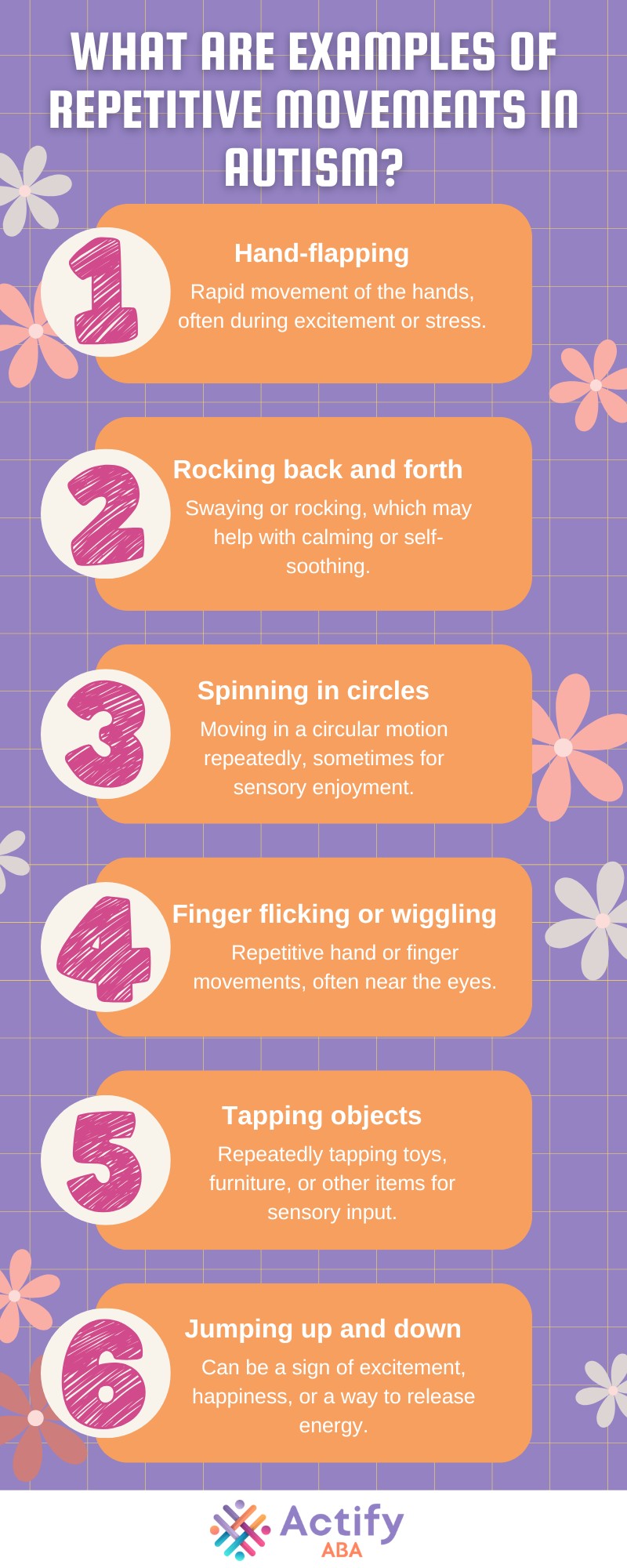
Key Points:
- Repetitive behaviors are a core characteristic of autism, often seen in movements, speech, and daily routines.
- Common examples include hand-flapping, echolalia, and strict adherence to routines.
- Understanding these behaviors helps parents and caregivers provide better support and intervention strategies.
Parenting a child with autism means noticing unique behaviors every day. Maybe your child rocks back and forth or insists on following the same routine. These repetitive actions aren’t just habits—they play a crucial role in how autistic individuals experience and interact with the world around them.
What Are Common Repetitive Behaviors in Autism?
Repetitive behaviors in autism refer to movements, vocalizations, or routines that are repeated frequently and consistently. These behaviors can be categorized as either motor movements, verbal repetition, or ritualistic routines. They often serve as a way for individuals with autism to regulate emotions, seek sensory input, or express needs.
Some children engage in repetitive behaviors to cope with stress, while others use them to self-soothe. Recognizing and understanding these behaviors can help families determine the best ways to support their child’s development.
Many children with autism engage in repetitive physical movements, also known as self-stimulatory behavior (or “stimming”). These behaviors provide sensory feedback and can be a way to manage emotions.

These movements may seem excessive to others, but they often serve a necessary purpose for the individual engaging in them.
Verbal Repetitive Behaviors in Autism
In addition to physical movements, many children with autism engage in repetitive speech patterns, also known as echolalia or scripting. These behaviors can be a way to process language, express emotions, or communicate needs.
Examples of repetitive speech include:
- Echolalia – Repeating words or phrases heard from others, such as mimicking dialogue from TV shows.
- Scripting – Reciting entire conversations or movie lines, often in a way that seems out of context.
- Repetitive questioning – Asking the same question multiple times, sometimes as a way to seek reassurance.
- Repetitive sounds or noises – Making nonverbal sounds or humming consistently.
- Word repetition – Saying the same word or phrase over and over, sometimes as a way to self-soothe.
While echolalia can sometimes hinder typical conversations, it can also serve as a stepping stone for language development in autistic children.

Why Do Children with Autism Engage in Repetitive Behaviors?
Repetitive behaviors in autism serve different purposes depending on the child. While they may seem unusual to others, these actions often help autistic individuals self-regulate, communicate, or process sensory input. Understanding the reasons behind these behaviors allows caregivers to provide better support and create a more accommodating environment.
- Sensory Regulation – Many children with autism experience sensory sensitivities. Some engage in repetitive behaviors, like rocking or hand-flapping, to seek sensory input, while others use them to block overwhelming stimuli. These actions help balance sensory experiences and prevent discomfort.
- Emotional Coping – Stress, anxiety, or excitement can trigger repetitive behaviors. A child may repeat words, spin, or tap objects as a way to self-soothe. These behaviors provide comfort and predictability, helping them manage strong emotions.
- Routine and Predictability – Many autistic children thrive on structure. Repeating actions or following strict routines provides a sense of control. Changes in routine can cause distress, making repetitive behaviors even more necessary for stability.
How Can Parents and Caregivers Support Children with Repetitive Behaviors?
Repetitive behaviors are a natural part of autism, and while some are harmless, others may interfere with daily life. Instead of trying to stop them completely, the goal is to understand their purpose and help children manage them in appropriate ways.
Identify Triggers and Patterns
Observing when and why repetitive behaviors occur can provide valuable insight. Does your child flap their hands when excited or repeat phrases when anxious? Identifying triggers—such as sensory overload, stress, or boredom—can help in finding alternative ways to address their needs.
Offer Sensory-Friendly Alternatives
Many repetitive behaviors serve a sensory purpose. Providing sensory-friendly tools, like fidget toys, weighted blankets, or movement-based activities, can help fulfill that need in a less disruptive way. Occupational therapy can also offer strategies tailored to your child’s specific sensory profile.
Encourage Communication and Emotional Regulation
For some children, repetitive behaviors are a way to express emotions or communicate needs. Teaching alternative communication methods, like visual schedules, sign language, or AAC devices, can reduce frustration while giving them a structured way to express themselves effectively.
Use Positive Reinforcement
Instead of discouraging repetitive behaviors with punishment, use positive reinforcement to encourage adaptive alternatives. Praising a child when they use a coping strategy or redirecting them to a more appropriate behavior can be more effective in the long run.
Establish Predictable Routines
Children with autism thrive on structure. Maintaining consistent daily routines can provide stability, reducing anxiety-driven repetitive behaviors. Preparing them for changes through visual schedules, countdown timers, or social stories can also make transitions smoother and less stressful.
Seek Professional Guidance
If repetitive behaviors become disruptive or interfere with learning and social interactions, seeking professional support can be beneficial. ABA therapy, occupational therapy, and speech therapy offer individualized strategies to help children manage behaviors while developing essential life skills.
Support Your Child’s Growth with ABA Therapy
Repetitive behaviors in autism are a natural part of the condition, but they don’t have to be barriers to growth. Understanding repetitive behavior autism examples can help parents provide better support while ensuring their child thrives in different environments.
At Actify, we specialize in personalized ABA therapy in MD, helping children develop essential life skills while managing behaviors effectively. Our trained therapists work closely with families to create tailored intervention plans that promote positive outcomes.
We proudly serve families in Maryland and surrounding areas. Contact us today to learn more about how we can support your child’s progress through evidence-based ABA therapy!
